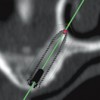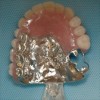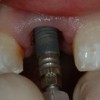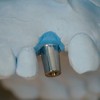The denture using population is mostly elderly and often oral signs and symptoms may be indicative of underlying medical disease. Topics addressed include a review of pertinent medical and dental history findings, the proper methods for conducting oral-facial demands and prosthodontic assessment. Exam factors which impact retention, stability and support are addressed in detail.
Complete Dentures – History and Exam — Course Transcript
- 1. 3. History and Exam John Beumer III, DDS, MS and Robert Duell, DDS Division of Advanced Prosthodontics, Biomaterials and Hospital Dentistry UCLA School of DentistryThis program of instruction is protected by copyright ©. No portion ofthis program of instruction may be reproduced, recorded or transferredby any means electronic, digital, photographic, mechanical etc., or byany information storage or retrieval system, without prior permission.
- 2. History and Clinical Exam• Medical and dental history• Orofacial exam• Prosthodontic assessment• Prognosis• Preliminary impressions• Tissue conditioning
- 3. Medical History Potential medical emergencies Effects on denture supporting tissues Effects on oral neuromuscular control
- 4. Effects of Smoking Predisposition to oral cancer Predisposition to periodontal disease Success – failure rates of osseointegrated implants
- 5. Oral Facial Exam:Oral cancer screening examExam for other pathology Local SystemicProsthodontic assessment
- 6. Intraoral and Extraoral ExamPalpate the temporomandibular joint Checking for: • Clicking • Popping or crepitus
- 7. Intraoral and Extra Oral ExamConduct a thorough oral cancer screeningexam • Lips and cheeks •Lateral border of the tongue •Floor of the mouth •Tonsillar region and the soft palate •Base of the tongue •Oropharynx •Neck
- 8. Extraoral ExamLymphatics The first sign of oral cancer is often a palpable lymph nodeLips and cheek
- 9. Examination of the Lips and Cheeks Visual inspection Palpation BidigitalYou are palpating for: • Lumps and bumps, indurations etc.
- 10. Intraoral Exam Examine the denture bearing surfaces, the soft palate, tonsillar region, the vestibules and the buccal mucosa. Hamular notch
- 11. Intraoral Exam Examine the lateral borders of the tongueExamine the ventralsurface of the tongueand the floor of themouth.
- 12. Oral Lesions and Disease Factors Impact on Complete Dentures Diabetes (long term insulin dependent) Epithelium is thinner and less keratinized. Result: Compromised, support and impaired tolerance of complete dentures.
- 13. Disease FactorsWickham’s striae Oral Lichen Planus – Erosive lesions and subsequent scarring in the buccal shelf area limit denture extension in this region and make it difficult for some patients to tolerate their dentures. Result – Compromised support and tolerance of the mandibular denture.
- 14. Disease Factors Pemphigoid – Chronic ulceration with subsequent scarring of the oral mucosa. Result – Limited denture extensions compromising support, stability, retention and tolerance of complete dentures.
- 15. Chronic CandidiasisMild Low saliva flowCandidiasis rates leads to increased numbers of fungal organismsSevere leading to a highCandidiasis incidence of chronic Candidiasis.Angular cheilitissecondary to chronicCandidiasis.
- 16. Clinical ManifestationsBurning and irritation of the denturebearing mucosa, making tolerance ofcomplete dentures difficult. In additionthe fungus is keratolytic, furthercompromising support and tolerance.
- 17. TreatmentTopical antifungal therapy followedby relining of the dentures (Nystatinis the drug of choice. It can bedispensed as a cream, a powder oran oral lozenge).
- 18. Common Oral Lesions Inflammatory fibrous hyperplasiaBegins as a traumatic ulcer secondary to an overextended denture flange.
- 19. Common Oral LesionsInflammatory fibrous hyperplasia Continued denture wear and irritation leads to inflammatory fibrous hyperplasia (epulis fissuratum). Therapy – Surgical excision
- 20. Common oral lesions Inflammatory papillary hyperplasiaSecondary to ill fitting maxillary dentures. Usually complicated bychronic candidiasis.Therapy: Antifungal medications applied topically. In extreme cases,surgical excision.
- 21. Therapeutic Approaches – Palatal PapillaryHyperplasia**with Associated Candida Albicans Antifungal therapy* a) Reline or remake denture b) Nystatin powder (100,000 units per gram) Apply to undersurface of denture three times per day for 3-4 weeks c) Nystatin cream – Best used for lesions associated with the corners of the mouth d) Reline denture with temporary reline materialSurgical excision with electrosurgery (when antifungal therapy has reached an end point) *Nystatin rinse is generally ineffective. Nystatin oral or vaginal suppositories used as an oral lozenge are reserved for fungal infestations that extend beyond the denture bearing surfaces. **Is this a premalignant lesion? No!!!!
- 22. Other Oral Lesions of Importance Premalignant Lesions Leukoplakia ErythroplakiaBoth these lesions can transform into Squamous Cell Carcinomas
- 23. Other Oral Lesions of Importance Squamous cell carcinomasUnless detected early most patients with squamous carcinoma have asurvival of less than 50%. Early detection dramatically improves survival.
- 24. Other Oral Lesions of Importance Squamous Cell CarcinomaA •A thorough oral cancer screening exam must be performed on all patients considered for complete dentures. •Early oral cancers (A) are difficult to detect and may be confused with other phenomenon, but the cure rates are high.B •Advanced oral cancers (B,) are easy to detect, but cure rates are very low. •Our challenge is to detect oral cancers when they are small, localized, and treatable.
- 25. Oral Exam Clinical Factors InfluencingStability, Retention, and Support of Complete Dentures
- 26. Definitions – Removable Prosthodontics Retention – Resistance to vertical displacement of the denture away from the denture bearing surface during. Stability – Resistance to lateral displacement of the denture during function. Support – Resistance to vertical forces of occlusion. Factors of the bearing surface that resist or absorb occlusal loads during function.
- 27. What factors associated with thedenture bearing tissues influencethe quality of retention,stability, and support providedthe complete denture?
- 28. Quality of Bearing Surface Mucosa Affects Support. a) Degree of keratinization b) Amount of attached mucosa vs unattached mucosa Stratum corneum Stratum granulosum Stratum spinosum Basal layer Keratinized Lamina propria Less keratinized The more keratinized attached mucosa available, particularly in the mandible, the better the support.
- 29. Keratinized Attached mucosa is theRemnant of Attached Gingiva. Mucogingival junction Attached Gingiva Keratinized attached mucosaThe more available on the denture bearing surfaces, the better the support.
- 30. Maxilla vs Mandible Note the amalgam tattooMaxilla – Abundance of Mandible – Narrow zone of keratinized attached mucosa. keratinized attached mucosa. Covers entire palate and alveolar Confined to the alveolar ridges. ridges.
- 31. Loss of Keratinized Attached MucosaResult:(a) Reduced support.(b) Reduced tolerance to occlusal load. Zone of keratinized mucosa
- 32. Ridge Resorption What is the impact of boneresorption on retention, stability, and support?All three are negatively impacted.
- 33. Pattern of Ridge Resorption* The rate of resorption is much higher in the mandible than in the maxilla.*Talgren, 1964
- 34. Ridge Resorption Resorption patterns in the edentulous patients* *From Zarb et al, 1983
- 35. Ridge ResorptionNote the sharp mylohyoid ridge (arrow)
- 36. Mandible – Prime Support Areas Retromolar pad Buccal shelf Alveolar process*Of the above, the alveolar process is most affected by the process of bone resorption
- 37. Retromolar PadOne constant, relatively unchanging structure on the mandibulardenture bearing surface is the retromolar pad (dotted line).The pad contains glandular tissue, loose areolar connective tissue,the lower margin ofthe pterygomandibular raphe, fibers of the buccinator, and superior constrictor and fibersof the temporal tendon. The bone beneath does not resorb secondary to the pressureassociated with denture use. It is one of the primary support areas.
- 38. Buccal Shelf Masseter groove Boundaries of the buccal area shelf: The external oblique line and the crest of the alveolar ridge (area within the dotted lines). Buccinator limits the extension in this areaThe buccal shelf is a prime support area because it is parallel to the occlusalplane and the bone is very dense. It is relatively resistant to resorption.
- 39. Buccal ShelfBuccal shelf area (area within the dotted lines). The greater the access tothe buccal shelf the more support there is available for the denture. Accessis determined by the attachment of the buccinator.
- 40. Patterns of Resorption – MandibleMandible – initially buccal lingual dimension of the alveolarridge is narrowed, compromising support (A, B, C).A B C
- 41. Patterns of Resorption – Mandible EDBut thereafter, the height is affected compromisingsupport,stability, and retention (D,E).
- 42. Patterns of Resorption – MandibleMylohyoid ridge Continued calcification of the attachment of the mylohyoid muscle leads to the development of a sharp bony projection on the lingual surface. The mucosa overlying this region is poorly keratinized and prone to perforation secondary to trauma from complete dentures.
- 43. Pattern of Resorption – MaxillaLabial plate Following extraction, resorption is from buccal- labial towards the lingual.Result: Some compromise of stability and support.
- 44. Patterns of Resorption – MaxillaContinued resorption leads to loss of vertical height of the alveolus. Result: a. Significant compromise of stability of the denture. b. Pseudo-class III jaw relation. c. Secondary affect – compromised retention because of compromised stability. Peripheral seal of the denture is more easily broken because there is little resistance to lateral displacement of the denture during function.
- 45. Combination Syndrome It produces a very specific pattern of resorption of the maxilla. It is caused by edentulous maxilla opposing dentate mandible whereanterior dentition has been retained and where the denture has not beenproperly balanced. Note steep anterior guidance. There are no contacts in working, balancing or protrusive when the patient goes through the chewing cycle. As a result, during the chewing cycle , the denture tips anteriorly, compressing the mucoperiosteum of the premaxilla, leading to resorption of the bone of the premaxillary area.
- 46. CombinationSyndrome Result: (a) Resorption of premaxilla (b) Hypertrophy (fibrousResorbed hyperplasia)premaxilla of maxillary tuberosity. (c) Occlusal plane problems. Hypertrophic maxillary tuberosities Occlusal plane
- 47. Mandible – Similar Phenomenon ObservedResorption can be so severe as to require augmentation with bone graftsin order to prevent pathologic fracture of the mandible.
- 48. Measures to Prevent or Slow Resorption.1. Well adapted and properly extended dentures withproperly designed and executed occlusion.2. Retention of residual tooth roots in key locations.3. Use of osseointegrated implantsRetained roots and osseointegrated implants are useful because theyabsorb much of the occlusal load locally, thereby preventing compressionof the periosteum and in turn preventing resorption of the adjacent bone.
- 49. A Preventive Measures Retained root tips (A) and Osseointegrated implantsB (B, C) The denture rests on the implants or root tips. Compression of theC mucoperiosteum is minimized, preventing resorption of the underlying bone.
- 50. Preventive MeasuresNote tissue bar connected to the implants Bar facilitates retention, stability and provides support in the anterior region.
- 51. Other Factors – Frenum AttachmentsFrenum – Folds of mucus membrane containing fibrousconnective tissue (A) (arrows). A BFrenum are of little consequence. However, they may limitdenture extensions (B) (arrows) or make seal difficult tomaintain, and occasionally affect the retention of the maxillarydenture.
- 52. Other factors – Frenum attachments Lingual frenum Mandibular frenum. If they are prominent they may affect denture extensions, particularly the lingual frenum Buccal frenum
- 53. Floor of Mouth Posture and Tongue PositionA Floor of mouth posture and tongue position (depth of retromylohyoid space) affect stability and retention. Favorable anatomy as seenB here (A, B,) permits development of a longer lingual flange. Result: Improved stability and retention of the mandibular denture
- 54. Favorable Floor of Mouth PostureImpressions and dentures made for patients withfavorable floor of mouth posture and favorable(anterior) tongue position. Note length of lingualflange. Stability and retention are enhanced.
- 55. Unfavorable Floor of Mouth Posture and Retruded Tongue PositionPatients with unfavorable floor of mouth posture and tongueposition (A, B). The tip of the tongue has lost its definitionand is retruded and the floor of the mouth is elevated. A BResult: Length of lingual flange of the denture will be limited, compromisingstability, retention and the ability of the patient to control the lower denture.
- 56. Determining Floor of Mouth Posture Carefully examine the retromylohyoid space to determine the floor of mouth
- 57. Solutions – Retruded Tongue Position and Unfavorable Floor of Mouth Contour. 1. Dentures retained with osseointegrated implantsResult:a. Improved retention. Note denture snaps onto retention bar.b. Improved stability (from the implants and the tissue bar).c. Improved support (anteriorly).d. Better control of the bolus (tongue no longer must position denture and controlthe bolus simultaneously).
- 58. Solutions – Retruded Tongue Position and Unfavorable Floor of Mouth Contour. 2. Skin graft vestibuloplastyThis surgical procedurehas been used toovercome problems Residual Skin grafted areas keratinizedcaused by a retruded attached mucosatongue position,unfavorable floor of mouthposture and a narrowresidual zone ofkeratinized attachedtissue. Muscle attachments in the floor of the mouth are lowered and the zone of attached keratinized tissue is widened with the skin graft. a.Result: Improved stability and retention of the denture because the lingual flange is lengthened. b.Result: Improved support, because the zone of attached keratinized tissue is dramatically widened.
- 59. Impact of Saliva and Salivary Glands Palatal glands
- 60. Posterior Palatine Salivary Glands The presence of these glands permit compression of the tissues helping to overcome poor adaptation of Glandular tissue the denture in this area secondary to shrinkage ofPosterior palatal the acrylic resin during seal area processing. Peripheral seal of the denture is thereby maintained.
- 61. Posterior Palatine Salivary GlandsWhen making impressions this area of tissue is compressed, allowing us tocompensate for shrinkage of the acrylic resin during polymerization andmovement of the denture base during function.Result: Tissue adaptation of the denture is maintained and therefore peripheralseal and retention of the maxillary complete denture is maintained.When these glands atrophy, the tissue become less compressible makingit more difficult to obtain and maintain peripheral seal.
- 62. Posterior Palatal Seal AreaShrinkage of acrylic resin is also accounted for byscoring the cast in the postdam area (arrow).
- 63. Salivary Flow and RetentionLow flow rates• Difficult to achieve and maintain peripheral seal of the maxillary denture• Compromised adhesion and cohesion.
- 64. Saliva as a LubricantLow flow rates• Primarily affects the mandibular denture bearing surfaces.• Results in more friction at the mucosa- denture interface as the mandibular denture slips and slides over the denture bearing surface during function.
- 65. Neuromuscular Control• Some patients have the ability to manipulatetheir lower denture and control the bolussimultaneously, regardless of the quality of thedesign and construction of the denture.• Many patients with good neuromuscular controlcan overcome unfavorable bearing surfacecontours and anatomy and chew efficiently withtheir complete dentures and the converse is alsotrue.
- 66. Tissue Factors Affecting SupportMandible: Maxilla:• Retromolar pad • Amount of keratinized• Alveolar ridge contours (the mucosa broader the more support) • Alveolar ridge contours• Amount of attached • Palatal shelf area and keratinized mucosa (the contour more present the better the support)• Buccal shelf area (the more access and the greater the surface area the better the support
- 67. Tissue Factors Affecting StabilityMandible: Maxilla:• Alveolar ridge height • Alveolar ridge height• Floor of mouth contour • Presence of well formed (favorable vs. unfavorable) maxillary, moveable• Tongue position denture bearing (anterior vs. retruded) surface tissues• Neuromuscular control tuberosities• Presence of flabby, • Presence of flabby moveable denture bearing surface tissues.
- 68. Tissue Factors Affecting RetentionMandible: Maxilla: • Shape of the palatal vault (peripheralPrimary Factors: seal)• Tongue position • Drape of the soft palate – House• Floor of mouth posture classification (peripheral seal)• Neuromuscular control • Quality and quantity of saliva (peripheral seal)Secondary Factors • Compressibility of posterior palatal seal• Peripheral seal area (peripheral seal)• Adhesion • Presence of well shaped tuberosities• Cohesion • Height of alveolar ridge (resistance to lateral displacement)
- 69. Clinical exam – Prosthodontic Assessment Assessment of existing dentures • Retention • Stability • Vertical dimension of occlusion • Centric relation • Esthetics
- 70. Prosthodontic Assessment Posterior teeth • Tooth forms • Materials • Wear
- 71. Prosthodontic AssessmentRetention – MaxillaApply a tipping force to the incisors in an attempt to break seal
- 72. Prosthodontic AssessmentStability – Maxilla
- 73. Prosthodontic AssessmentStability and Retention – Mandible
- 74. Prognosis based upon: • Bearing surface anatomy, tongue position and floor of mouth posture • Neuromuscular control • Denture history • Psychological classification
- 75. Visit ffofr.org for hundreds of additional lectures on Implant Dentistry, Removable Partial Dentures, Esthetic Dentistry and Maxillofacial Prosthetics. The lectures are free and available upon registering for the site. Our objective is to create the best and most comprehensive online programs of instruction in Prosthodontics on the internet.


 Prosthodontic Procedures and Complications
Prosthodontic Procedures and Complications
 Implants and RPDs
Implants and RPDs
 Single Tooth Defects in Posterior Quadrants
Single Tooth Defects in Posterior Quadrants
 Cement Retention vs Screw Retention
Cement Retention vs Screw Retention
